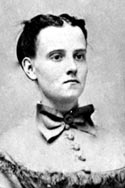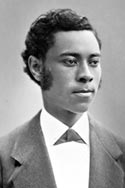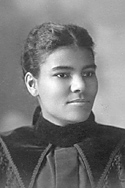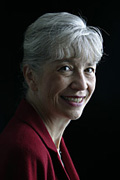Enduring Values in a Changing World
Bates is rightly celebrated as one of the first U.S. colleges to offer a true equal-opportunity education, one for all students regardless of gender, race, religion or socio-economic status. Bates is now famous for its academic rigor, its powerful and open community and its strong tradition of service. But where did these remarkably enduring values come from?
To answer this question, we turned to Professor Emeritus of History James S. Leamon, who has experienced Bates as a student, as an alumnus with the Class of 1955 and as a faculty member appointed in 1964. After spending a few summer weeks examining Bates early history, he offered these thoughts.
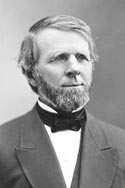
During the night of Sept. 22, 1854, the Rev. Oren B. Cheney made a decision. As a deeply religious man, he called it a vision, and this vision would transform his life and the lives of thousands of others. Cheney was convinced that he should resign his Freewill Baptist pastorate in Augusta, Maine, and dedicate his life to founding a new educational institution.
Cheney imagined a radically new type of school, an idea that came after hearing the shocking news that Maine’s only Freewill Baptist school, in the southwestern town of Parsonsfield, had burned to the ground. Not only had Cheney attended that school as a boy, but, upon graduating from Dartmouth College, he had returned there to teach and to serve as principal.
Parsonsfield was a seminary, a 19th-century term signifying a private school offering a high school education, in this case under the auspices of the Freewill Baptist denomination. The school welcomed boys and girls, and the most promising boys were “fitted” for college. The loss of Parsonsfield inspired Cheney not merely to build a replacement, but to establish a different school, as he later described it, one of “a high order or grade somewhere between a College and an Academy,” and to do so in a conveniently central location in Maine.
A former Maine legislator, Cheney used persistence and political skill to secure from the state Legislature a charter for the Maine State Seminary, on March 16, 1855, along with an appropriation of $15,000. To attract the new school to their growing industrial town, Lewiston’s political and business leaders provided land and additional funds.
But for Cheney this was only the first step. There is good reason to suspect that Cheney’s original vision extended far beyond a mere seminary, for within 10 years he had transformed the Maine State Seminary into a four-year college. An experienced educator and politician, Cheney realized that had he proposed a college in 1855, opposition would have arisen from competing educational institutions and religious denominations. The financial obstacles, too, would have been doubly challenging.
Instead, he moved toward his goal incrementally: the Maine State Seminary first, the addition of a “collegiate department” in 1862 and, finally, a new charter on Jan. 19, 1864, turning the seminary into Bates College, named to honor its chief benefactor, Benjamin E. Bates, a Boston and Lewiston industrialist.
Bates College was born from the fusion of two powerful reformist movements that gave it a distinctive character and purpose. The religious excitement of the 18th century, called the Great Awakening, eventually merged with the intense reform impulses of the mid-19th century. Out of the Great Awakening arose a host of religious sects and splinter groups, including Freewill Baptists, all with the goal of seeking spiritual satisfaction outside the more traditional denominations. As the name implies, Freewill Baptists emphasized the freedom of any individual, regardless of class, gender or race, to accept God’s gift of salvation through one’s own personal decision — one’s own “free will.”
The practical application of these religious convictions led Freewill Baptists to emphasize the spiritual and intellectual equality of men and women and aggressively to oppose the institution of slavery – to the point of excluding from membership those who owned slaves. Freewill Baptist beliefs readily merged with the turbulent reformist surge sweeping through the Northeast in the decade before the Civil War. William Lloyd Garrison and John Brown personified the abolitionist crusade, while Catherine Beecher, Emma Willard and Mary Lyon, among others, gave voice to the women’s rights movement.
The reformist enthusiasms of the mid-19th century, sanctified by Freewill Baptist principles, deeply affected Cheney. He fiercely advanced the cause of temperance, viewing alcohol as a destroyer of one’s free will. But the cause of abolition aroused his greatest passion. In the Freewill newspaper The Morning Star of Oct. 5, 1853, he wrote about slavery: “We hate it – we abhor it, we loath it – we detest and despise it as a great sin against God, and an awful crime against man.” As did his father, Cheney participated in the Underground Railroad, openly entertained in his home notable black leaders such as Frederick Douglass and Sojourner Truth, and enjoyed the personal friendship of one of the most ardent opponents of slavery in the U.S. Senate, Charles Sumner of Massachusetts.
Most colleges established in the 18th and 19th centuries reflected the principles of their religiously affiliated founders, and Cheney’s college was no different. Education, he believed, could leverage the power of one’s free will and personal freedom. From the outset, Bates would be open to all, and its charter was bold for what it did not include: any restriction on enrollment by race, gender or religious denomination.
The College initially attracted young men from New England’s hinterlands, but the charter, perhaps inspired as much by Cheney’s wife, Emeline, as by reformist idealism, specifically provided for the enrollment of “females.” Bates soon became something of a novelty – and subject to mean-spirited ridicule in Maine – as New England’s first co-educational college. “How much it cost the college in standing and influence to admit a woman…before it had graduated a class – I very well know,” wrote Cheney in his 1885 president’s report. But, he predicted, it “is only a question of time” before “all the colleges of our country will welcome women to their numbers.” Cheney also tried to recruit black students, even traveling to Virginia just after the Civil War to find likely candidates. Bates would graduate its first black student in 1874 (ironically, he was a native Mainer), and by 1877 the College had nine blacks enrolled, six of whom had been slaves.
With no religious requirement for admission, Bates was technically a nonsectarian institution. To be sure, a Freewill Baptist ethos pervaded the College, and the moral tone of the campus reflected Freewill religious convictions. Religious revivals were encouraged, consumption of alcoholic beverages was forbidden and fraternities and sororities were banned, lest they detract from the egalitarian sentiment Bates strove to incorporate.
In the early days, perhaps only partly by design, poverty became something of a unifying, college-wide theme – even for President Cheney, who mortgaged his house to meet debts related to the institution. He spent most of his life – and his health – in countless cross-country trips raising funds, and his successes ranged from one-dollar contributions from Baptist Sunday school children to the timely gift of $100,000 by Benjamin Bates.
Indeed, the College’s early history was marked by a lack of funds and brushes with financial despair. Despite these hardships, Cheney insisted on keeping tuition modest, yet most students still depended on scholarships from Bates or their local churches, or on the meager income from teaching or preaching in neighboring communities during vacations. Mary Wheelwright Mitchell, the first woman to graduate from Bates, in 1869, paid college expenses by working in a Lewiston cotton mill and refused a scholarship offered by President Cheney so that another student might benefit.
Just as a modern sports team is energized by being cast as the underdog, Bates and its students found moral advantage in their hardscrabble reputation. Indeed, poverty could be “one of the best tests of human character,” noted an early College publication. So in contrast to wealthier, more elitist traditional colleges, Bates stood proud of its distinguishing characteristics as a no-frills, socially democratic and inclusive educational institution, where students might develop their God-given talents in ways beneficial to society. Some years after the College’s founding, Bates’ second president, George Colby Chase, of the Class of 1868, would say that Cheney and his supporters “embodied [a] protest against castes, classes and social tyrannies, whether originating in human slavery or in human vanity, pride and snobbishness. It was their aim to establish an institution in which the rich and the poor, the highest and the humblest might mingle on equal terms in the spirit of mutual helpfulness.”
To this day, a spirit of “mutual helpfulness” on campus blurs any dividing lines that might otherwise exist between students of various socio-economic strata. Sons and daughters of American public and corporate leaders, and men and women who could not receive a Bates education without significant financial aid, together work, live and learn without concern for, or much attention to, their varying backgrounds.
As he succeeded Cheney in 1894, President Chase expressed these ideals in his inaugural address. In phraseology that may appear quaint to modern readers, Chase extolled a student body that was “earnest, pure, reverent, simple in their habits, frugal in their lives, democratic in their sympathies, eager in their pursuit of knowledge,” and, he added, committed to the betterment of society. To these “high ideals” Chase promised the college would be true.
And it has. Times, terms and contexts change, and today many of the ideals of Bates’ founders have merged with mainstream reforms. Lest the boldness and foresight of Cheney’s original vision be obscured, we remind ourselves of its legacy today.
The 19th-century reform movement of which Cheney was a leader would give rise to Bates’ historic commitment to social activism. The College’s Harward Center for Community Partnerships, for example, provides the most visible institutional link between campus academic programs and service that is local, national and global in scope.
Cheney’s radical inclusiveness, which in the late 19th century meant the admission of women and freed blacks together with white males, continues today with more than 14 percent of the student body being minorities and international students. Women now compose almost half the faculty, including the English scholar who serves as the College’s seventh president, Elaine Tuttle Hansen.
The College’s commitment to scholarships and financial assistance, in part, prompted The Princeton Review recently to name Bates its No. 1 “Best Value” college in America. Absent still from the campus are fraternities and sororities, and our collegiate peers have come late to the recognition that these societies can be divisive, undemocratic and a detriment to rigorous study. Many of the very strongest colleges in the United States, some of whom once regarded our college as an unwelcome upstart, now strive to incorporate Bates values of democratic inclusiveness, diversity and commitment to social service.
Indeed, what seemed in the 1850s like a quixotic dream is now a model of much of American higher education, a powerful example of vision giving birth to excellence. This is Cheney’s legacy. It leads Bates in the present and provides our inspiration for the future.
